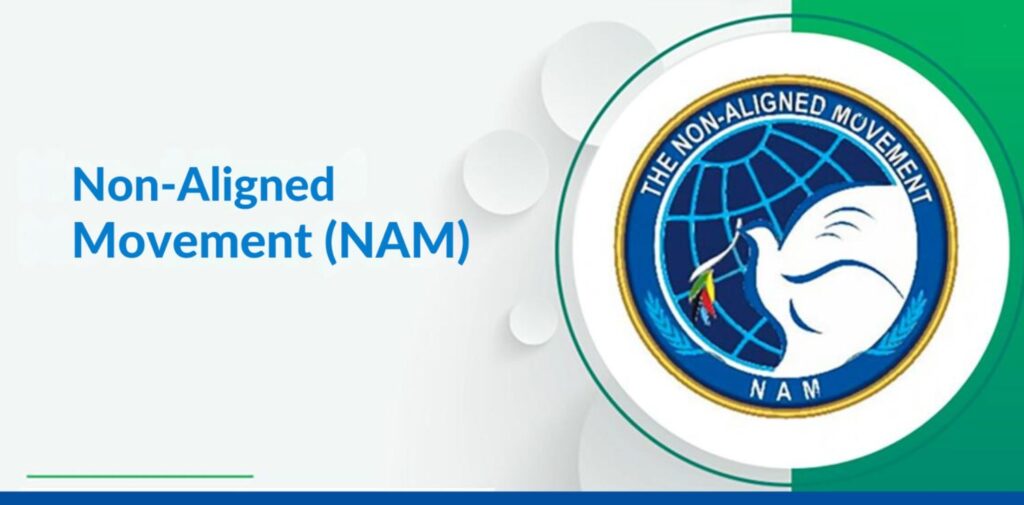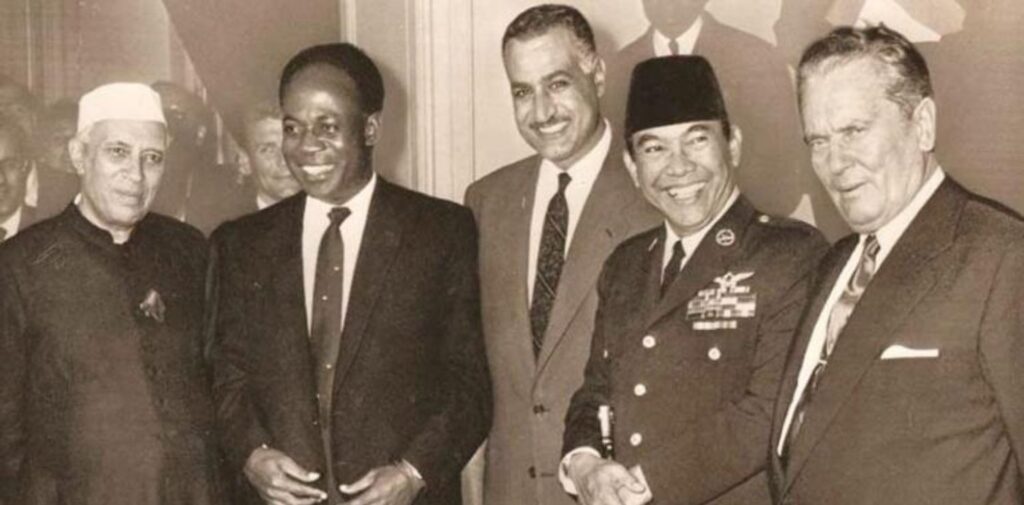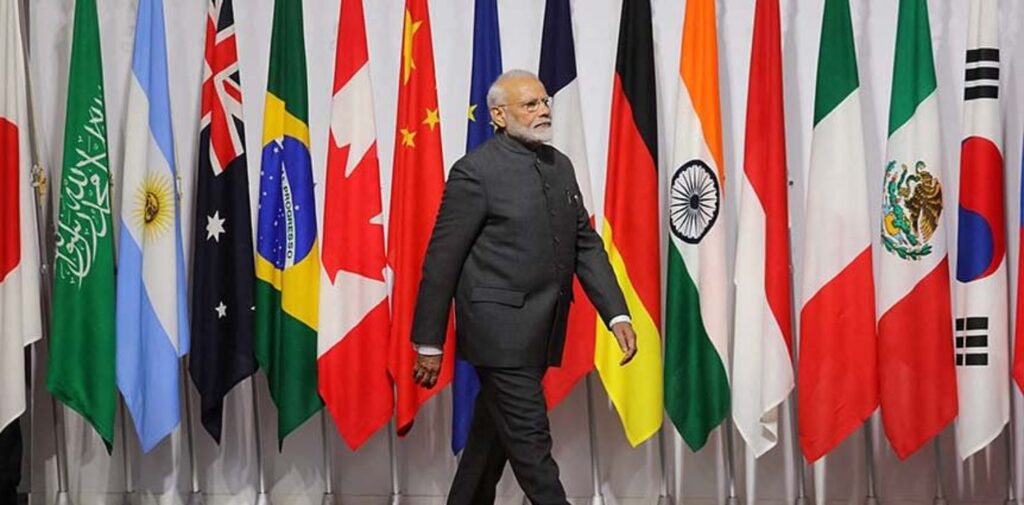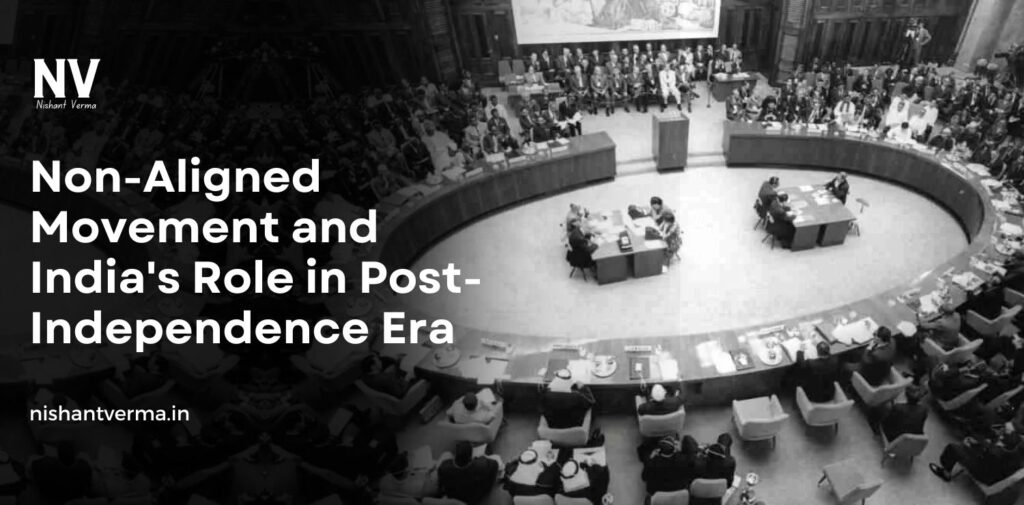The Non-Aligned Movement (NAM) played a pivotal role in shaping the foreign policy of India after it gained independence in 1947. At a time when the world was deeply divided during the Cold War, India, under the leadership of its first Prime Minister Jawaharlal Nehru, chose to adopt a path of non-alignment rather than aligning with either the United States or the Soviet Union. This decision had far-reaching consequences for India’s diplomacy and international relations and allowed the country to play a unique role in global politics.
What Was the Non-Aligned Movement (NAM)?
The Non-Aligned Movement, as the name suggests, was an international organization that sought to stay neutral in the ideological and political rivalry between the two superpowers of the Cold War: the United States and the Soviet Union. NAM was not about rejecting alliances but about not getting caught in the influence or control of either bloc. It was based on the principles of peace, cooperation, mutual respect, and sovereignty, and it aimed at promoting global peace and development, particularly for newly independent nations.
The foundation of NAM was laid in the mid-20th century, when many countries in Asia, Africa, and Latin America were gaining independence from colonial rule. These countries, having recently fought against colonial powers, were wary of being forced into another form of dependency — this time, between the two global superpowers.

India’s Role in the Formation of NAM
India’s leadership in the Non-Aligned Movement was spearheaded by Jawaharlal Nehru, who strongly believed in the need for India to maintain its independence in foreign policy decisions. In the years following independence, India was deeply focused on nation-building, addressing poverty, and establishing itself on the world stage. Nehru recognized that aligning with one of the superpowers would have limited India’s freedom to make independent decisions, especially on issues affecting the country’s development and global peace.
Nehru, along with other world leaders like Egypt’s President Gamal Abdel Nasser, Yugoslavia’s President Josip Broz Tito, and Indonesia’s President Sukarno, was one of the founding figures of the Non-Aligned Movement. The movement was officially formed in 1961 during the first NAM summit in Belgrade, Yugoslavia. India’s support for the movement was driven by its desire to promote peace and cooperation between newly independent countries, without getting caught in the Cold War rivalry.
Core Principles of the Non-Aligned Movement
The Non-Aligned Movement was based on several core principles that shaped its approach to international relations:
- Non-Interference in the Internal Affairs of Other Countries: NAM members advocated for the respect of sovereignty and independence of all nations, and they opposed interference in the internal matters of any country by foreign powers.
- Peaceful Coexistence: The movement encouraged peaceful coexistence and diplomacy between countries, particularly in the context of Cold War tensions. It emphasized dialogue over conflict and sought to de-escalate tensions in international relations.
- Self-Determination: NAM strongly supported the right of all peoples to determine their political and economic future, without external pressures or domination.
- Mutual Respect for Sovereignty and Territorial Integrity: The movement stood firm on defending the sovereignty of nations and respecting their territorial integrity, which was especially important for newly independent countries.
- Disarmament: Another crucial principle was the call for global disarmament, particularly in terms of nuclear weapons. NAM sought to reduce global arms races and promote peace and security.

India’s Foreign Policy and NAM
India’s decision to join the Non-Aligned Movement was shaped by the nation’s unique situation in the post-independence period. India had just emerged from British colonial rule and was striving to establish itself as an independent and sovereign nation. Nehru, as India’s first Prime Minister, recognized the importance of staying neutral in global conflicts while focusing on economic development, national security, and fostering international relations.
Nehru’s vision of non-alignment was to keep India’s foreign policy independent and flexible, avoiding the rigid alliances formed during the Cold War. This policy helped India maintain its strategic autonomy, which was important in a world where many nations were caught in the battle between the United States and the Soviet Union.
India’s non-aligned stance allowed it to maintain friendly relations with both the West and the Eastern bloc. At the same time, it actively worked to foster closer ties with newly independent countries in Africa, Asia, and Latin America. India’s non-alignment policy helped it become a prominent voice for the developing world, particularly in organizations like the United Nations and the Commonwealth.
The Role of India in NAM
As one of the founding members, India played a significant role in shaping the direction of the Non-Aligned Movement. Jawaharlal Nehru’s leadership at the time made India a key player in global diplomacy. Under Nehru, India worked towards strengthening the NAM’s foundation and providing a platform for developing countries to assert their interests.
India actively participated in international forums and advocated for issues such as decolonization, the reduction of military tensions, economic development, and the elimination of poverty. Nehru’s vision of a peaceful, just world order resonated with many African and Asian nations that were newly independent and striving for progress.
India’s support for the Non-Aligned Movement also reflected its desire to keep away from the binary of Cold War alliances. By remaining neutral, India focused more on matters that directly affected its own development, such as poverty alleviation, education, and healthcare.
Challenges to Non-Alignment
While non-alignment was a guiding principle for India’s foreign policy, it was not without challenges. The growing tensions of the Cold War, particularly the rise of nuclear weapons and regional conflicts, often placed India in difficult situations. Additionally, the changing dynamics of global politics, especially after the Cold War ended, made non-alignment harder to maintain as a strict policy.
One of the challenges faced by NAM and India’s foreign policy was the rise of new alliances, such as the North Atlantic Treaty Organization (NATO) and the Warsaw Pact. While NAM tried to avoid direct involvement in the Cold War conflicts, the global situation often forced countries to take sides in major international crises.
India’s relationship with the Soviet Union, for instance, became closer over time, especially during the 1970s. India signed the Indo-Soviet Treaty of Peace, Friendship, and Cooperation in 1971, which led some critics to accuse India of leaning towards the Soviet bloc. Similarly, the growing economic ties between India and the United States in the 1990s after the Cold War led to questions about whether India could continue to uphold its non-aligned stance.

NAM’s Decline and India’s Changing Foreign Policy
In the post-Cold War era, the relevance of the Non-Aligned Movement has been questioned by many analysts. As global politics shifted towards new alignments, some countries felt that NAM was no longer effective in addressing modern-day challenges. India, for example, gradually moved towards stronger economic and political ties with countries like the United States and Japan. The end of the Cold War led to a shift in India’s foreign policy, with more emphasis on economic globalization, security cooperation, and strategic partnerships.
Despite this, India has remained committed to the core values of non-alignment, including the promotion of peace, security, and cooperation among nations. India continues to play an active role in multilateral forums such as the United Nations, the World Trade Organization, and the G20.
Conclusion
The Non-Aligned Movement played an essential role in shaping India’s post-independence foreign policy. Under the leadership of Jawaharlal Nehru, India took a bold step in choosing a path of neutrality in the Cold War era, helping it to focus on its development and maintaining its sovereignty in the international sphere. Though the global political landscape has changed dramatically since the days of NAM’s peak, India’s role in the movement remains a significant chapter in the history of the country’s foreign relations.
India’s continued advocacy for peace, non-interference, and self-determination reflects the enduring legacy of the Non-Aligned Movement, and even today, it shapes India’s diplomatic approach in dealing with complex global challenges. As the world becomes more interconnected and multipolar, the principles of non-alignment still resonate in India’s pursuit of an independent and balanced foreign policy.




